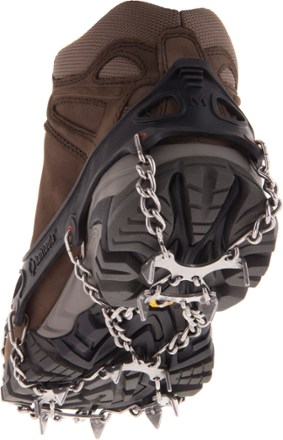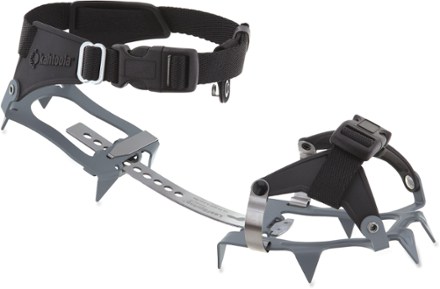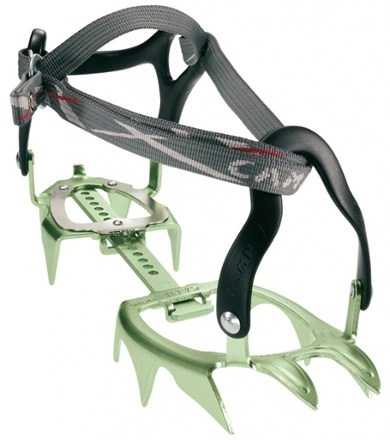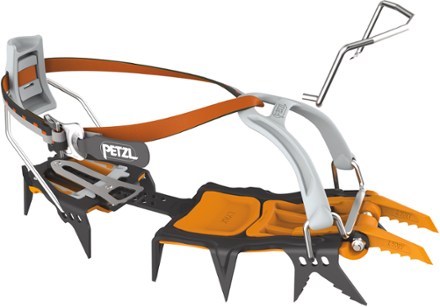Crampons: what to buy
2017-07-14
Alright... Let me say at the start of this article, I'm NOT an expert in this field. That being said, when I started researching what crampons to get I got really frustrated. Most of the articles out there are clearly written by people who don't know what they are talking about, AND don't actually know what's available. So I wanted to write something that least talks about ALL of the options, and what they are good for.
Nothing
A good shoe does a lot... don't neglect this option by any means. Mountaineers did a lot of mountaineering before crampons existed. Look up the "french method" and learn some of the techniques like chopping footsteps using an ice-axe. You should know these methods regardless, as they are still useful with crampons on, and might save your ass if a crampon fails or is lost somehow. You can also kick in steps in a lot of conditions. Now, just because someone experience can do something without crampons doesn't mean you can or should. Play it safe at first. A lot of people do die doing this kind of thing (including a friend of mine a few years ago actually). Judging what is dangerous is not intuitive initially. As you learn more you'll find that when you try and glissade (slide on your butt down) some hills that look terrifying when going up... you won't be able to. Clearly you could've done that hill without crampons.
So, play it safe at first, but keep this option in mind.
Yak-Traks etc.

Microspikes (and similar products)

These are right on the line between something just for around town or running on ice, and something that you might use for safety while mountaineering. They are extremely popular with thru-hikers who want to be able to go up/down snowy passes on the PCT/CDT in the early morning when the passes are still frozen over. They are super easy to slip on and off, which can be really nice in edge seasons. Notice that these can be worn on ANY shoe.
The thing to remember about microspikes is that the spikes are in fact quite small as the name implies. This means while they help on ice, they only dig in so far, they won't help at all on slightly soft snow or crumbly ice.
Instep crampons
From what I gather, don't buy these. After doing a lot of reading it seems that these have basically been replaced by Microspikes and their brethren.
This is like a partial crampon that goes on the instep of the shoe, the problem is that they are massively uncomfortable (pushing on the arch), make you unstable since you can't use your toes and heals for balance, and usually only have 4 or so smallish points. Overall microspikes give you more points, and better balance, and particularly give you points on the toe and the heal helping immensely while going up-hill and downhill respectively.
Snowshoes
Modern snowshoes usually have a crampon on the toe with pretty beefy spikes. Many, such as the MSR Lightning series also have some teeth on the bars. These can accomplish much that a crampon does, and often if you have snowshoes you can skip the crampons in moderate conditions. The trick is that while they usually work very well for keeping you from sliding while going up, they typically do a poor job going sideways and often worse than a simple shoe (with which you would post-hole and thus could make a flat platform) when going down. I've "skied" down more than one hill in snowshoes. These can usually be worn with any shoe, but can put uncomfortable pressure on the top of more minimal shoes.
Kahtoola KTS (and similar products)

Kahtoola KTS and a couple of other crampons are really in a class of their own. These are similar to hiking crampons of type 1 (that is, they fit any shoe), with one special caveat. These work on *flexible* soled shoes. They also have a strap system designed for the minimal uppers of running shoes making them a lot more comfortable with minimal shoes.
These are what Angie just purchased actually. For hikers (not mountaineers) who want a "do-everything" crampon that's light-weight, beefy enough for light mountaineering duty, and fit on lightweight shoes (like what thru-hikers wear), these are basically the only option. The tips are large enough to work in a softer conditions (but not super-soft).
This class of crampons can be further divided in to two subtypes, steel and aluminum. Aluminum are lighter, but dull quickly when used on rocks, and tend to have shorter points. This comes up when crossing short bits of rocks between snowy sections, or when rocks get iced over due to freezing rain (not something I personally have experienced yet).
Note that these crampons do not usually have front points. This means you are stuck walking sideways up steep slopes and when the going gets steeper than that, you'll have to turn around. This is particularly an issue on harder ice. As you start to move towards ice-climbing "toe pointing" techniques you are in over your head... time for something beefier (and probably to get a friend who knows how to ice-climb teach you). On the other hand, you can't stab the back of your other leg when you slip, having those front points is a mixed bag. Angie points out that the points are also a bit easier to deal with in or on your pack (I nearly stabbed her a couple times with my hiking crampons tied to my pack on our last trip).
Hiking crampons (types 1-3)

Similarly to the Kahtoola KTS class of crampons hiking crampons can be further divided in to 2 categories... aluminum and steel.
The biggest difference between these and Kahtoola KTS is that the bar between the toe and heal is not flexible, as a result if you wear them with flexible soled shoes that bar can apparently snap in half... This is really not what you want while hanging half-way up an ice-slope that you *needed* your crampons for in the first place.
Hiking Crampons are further divided in to 3 more categories though. Types 1 through 3.
Type 1) crampons fit "any shoe"... by this they mean any stiff soled (not very flexible) shoe with a heavy-weight upper and a sufficiently pointed toe. This means not running shoes, but stiffer hiking boots (not light hikers) will generally work well.
Type 2) fit "type 2" boots, these are boots with a special heal attachment point, but no such special attachment point on the toe. These are more secure and less likely to pop off while doing something more intense.
Type 3) fit "type 3" boots, these are boots with special attachments on both the toe and heal, these are the most secure, and also the fastest to pop on and off (short of microspikes).
For more on difference between types 1-3 see
https://www.rei.com/learn/expert-advice/crampons-snow-ice-climbing.html
Note that some of these crampons have front points, and some do not. Particularly down in the type 1 aluminum crampons... basically the ones for the least difficult conditions crampons tend not to have the front points, because they aren't meant for conditions where those are needed anyway.
Front points, as mentioned in above under the KTS crampons, are used for "front pointing". This is a technique used for extremely steep slopes when side-stepping no longer works well, particularly in harder icier conditions. At this point you are basically doing low-angle ice-climbing... so to be useful your crampon had better hold really well to your boot. Also, keep in mind that it's easy to stab your other leg with these front points, so be careful!
Climbing Crampons

If you are reading this article, you don't want these. These are for ice-climbing only, which is something I've never done, and completely outside the scope of this article.
Suffice to say that these usually fit specialized type 3 boots (though the ones above fit type 2 boots apparently), and they come in 2 major flavors, 1 and 2 front-points which I gather are used for different types of ice. Once again, this isn't my wheelhouse, if you are looking for these you hopefully already know what you are doing.
Conclusion
There's a reason for virtually every type of crampon to exist (possibly modulo instep crampons, which seem to just be cheap, and predate microspikes). It's a continuum and in most conditions a range of different options will be a reasonable choice.
No crampon is a substitute for knowing what you are doing. Knowledge will win out over gear virtually every time. But, that said, you have to start somewhere, and you need to buy something to get started. My first pair of crampons were a type 1 cro-moly (cross between steel and aluminum) hiking crampon with front points. Angie's first crampons were Kahtoola KTS... largely due to what I'd learned since I bought my first pair.
As a note, don't forget that you're feet aren't the only part that matters. If you are looking at anything past microspikes, you are probably also looking at hiking ice-axes (rather than technical ice-axes, which would go with climbing crampons). Often you can get away with only an ice-axe *or* crampons, for example.
People who are in these conditions a lot will usually end up owning more than one thing. I also own snowshoes, because they are useful for different conditions, and many people own climbing crampons, type 1 hiking crampons, AND microspikes for different conditions.

